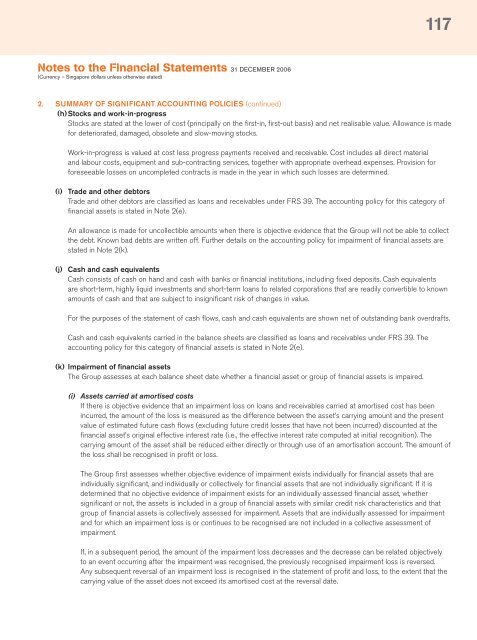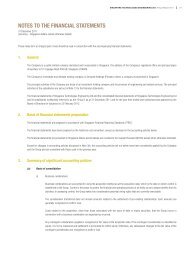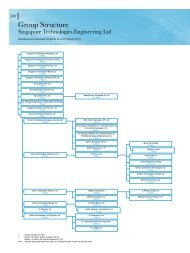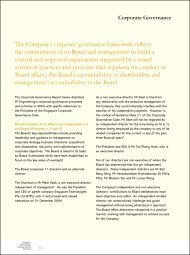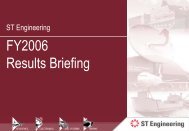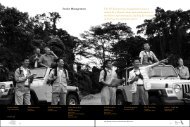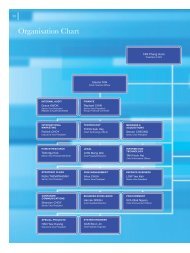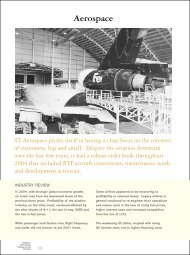Full Annual Report 2006 - Singapore Technologies Engineering
Full Annual Report 2006 - Singapore Technologies Engineering
Full Annual Report 2006 - Singapore Technologies Engineering
Create successful ePaper yourself
Turn your PDF publications into a flip-book with our unique Google optimized e-Paper software.
117<br />
Notes to the Financial Statements 31 DECEMBER <strong>2006</strong><br />
(Currency – <strong>Singapore</strong> dollars unless otherwise stated)<br />
2. SUMMARY OF SIGNIFICANT ACCOUNTING POLICIES (continued)<br />
(h) Stocks and work-in-progress<br />
Stocks are stated at the lower of cost (principally on the first-in, first-out basis) and net realisable value. Allowance is made<br />
for deteriorated, damaged, obsolete and slow-moving stocks.<br />
Work-in-progress is valued at cost less progress payments received and receivable. Cost includes all direct material<br />
and labour costs, equipment and sub-contracting services, together with appropriate overhead expenses. Provision for<br />
foreseeable losses on uncompleted contracts is made in the year in which such losses are determined.<br />
(i) Trade and other debtors<br />
Trade and other debtors are classified as loans and receivables under FRS 39. The accounting policy for this category of<br />
financial assets is stated in Note 2(e).<br />
An allowance is made for uncollectible amounts when there is objective evidence that the Group will not be able to collect<br />
the debt. Known bad debts are written off. Further details on the accounting policy for impairment of financial assets are<br />
stated in Note 2(k).<br />
(j) Cash and cash equivalents<br />
Cash consists of cash on hand and cash with banks or financial institutions, including fixed deposits. Cash equivalents<br />
are short-term, highly liquid investments and short-term loans to related corporations that are readily convertible to known<br />
amounts of cash and that are subject to insignificant risk of changes in value.<br />
For the purposes of the statement of cash flows, cash and cash equivalents are shown net of outstanding bank overdrafts.<br />
Cash and cash equivalents carried in the balance sheets are classified as loans and receivables under FRS 39. The<br />
accounting policy for this category of financial assets is stated in Note 2(e).<br />
(k) Impairment of financial assets<br />
The Group assesses at each balance sheet date whether a financial asset or group of financial assets is impaired.<br />
(i) Assets carried at amortised costs<br />
If there is objective evidence that an impairment loss on loans and receivables carried at amortised cost has been<br />
incurred, the amount of the loss is measured as the difference between the asset’s carrying amount and the present<br />
value of estimated future cash flows (excluding future credit losses that have not been incurred) discounted at the<br />
financial asset’s original effective interest rate (i.e., the effective interest rate computed at initial recognition). The<br />
carrying amount of the asset shall be reduced either directly or through use of an amortisation account. The amount of<br />
the loss shall be recognised in profit or loss.<br />
The Group first assesses whether objective evidence of impairment exists individually for financial assets that are<br />
individually significant, and individually or collectively for financial assets that are not individually significant. If it is<br />
determined that no objective evidence of impairment exists for an individually assessed financial asset, whether<br />
significant or not, the assets is included in a group of financial assets with similar credit risk characteristics and that<br />
group of financial assets is collectively assessed for impairment. Assets that are individually assessed for impairment<br />
and for which an impairment loss is or continues to be recognised are not included in a collective assessment of<br />
impairment.<br />
If, in a subsequent period, the amount of the impairment loss decreases and the decrease can be related objectively<br />
to an event occurring after the impairment was recognised, the previously recognised impairment loss is reversed.<br />
Any subsequent reversal of an impairment loss is recognised in the statement of profit and loss, to the extent that the<br />
carrying value of the asset does not exceed its amortised cost at the reversal date.


